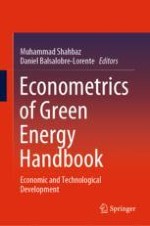2020 | OriginalPaper | Chapter
9. The Spillover Effect from Oil and Gas Prices: Evidence of Energy Shocks from Diebold and Yilmaz Index
Authors : Lucía Ibáñez-Luzón, Festus Victor Bekun, Andrew Adewale Alola, Daniel Balsalobre-Lorente
Published in: Econometrics of Green Energy Handbook
Publisher: Springer International Publishing
Activate our intelligent search to find suitable subject content or patents.
Select sections of text to find matching patents with Artificial Intelligence. powered by
Select sections of text to find additional relevant content using AI-assisted search. powered by
